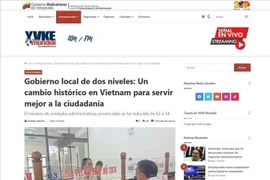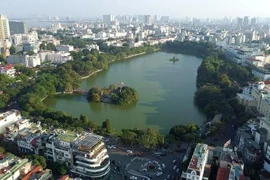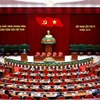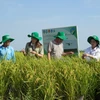Havana (VNA) – Latin American News Agency Prensa Latina has praised Vietnam’s official adoption of a two-tier local government model of provincial and communal levels from July 1, 2025, calling it a major milestone in the country’s public administration reform.
Prensa Latina cited expert opinions as affirming that Vietnam is entering “a new era of state governance” with a modern, dynamic, and accessible administrative system. It said the reform reflects a fundamental shift from command-based administration to a substantive people-centred model, with authorities “daring to think, act, and take responsibility” in the face of requirements from digital transformation and global integration.
The news agency highlighted General Secretary of the Communist Party of Vietnam (CPV) To Lam’s remarks, in which he stated that the reform transforms the principle of “a government that serves the people” from a slogan into reality. It quoted him as saying the reform is an essential response to the challenges of globalisation, digital transformation, and the Fourth Industrial Revolution.
The change comes at a significant point in time for Vietnam, coinciding with the 95th anniversary of the CPV, the 80th founding anniversary of the nation, and 40 years of the Doi Moi (Renewal) process. The historic transition was marked symbolically with bells ringing simultaneously at 18,491 pagodas nationwide in a collective prayer for peace and prosperity, Prensa Latina wrote.
It lauded Vietnam’s bold decision to strongly empower commune-level governments – the administration level closest to citizens, and streamline the state apparatus, potentially saving trillions of VND in budget expenditure. The move was described as a clear affirmation of the principle that “power belongs to the people”, thereby enhancing the legitimacy of public institutions.
The scale of the reform is significant. Vietnam has cut the number of administrative units from 63 provinces and cities to 34, and the number of communes and wards from over 10,000 to just 3,321. Prensa Latina called it a “comprehensive administrative revolution” that enables the creation of large and better-resourced local units to drive sustainable development.
The Latin American media also commended the integration of this reform with Vietnam’s national digital transformation programme. Despite some transitional challenges in decentralisation, 34 provinces and cities have completed the establishment of online public service systems.
Prensa Latina expressed confidence that the two-tier local government model will serve as a key driver for Vietnam’s green economic development and enhanced governance capacity amid the Fourth Industrial Revolution and deep international integration./.
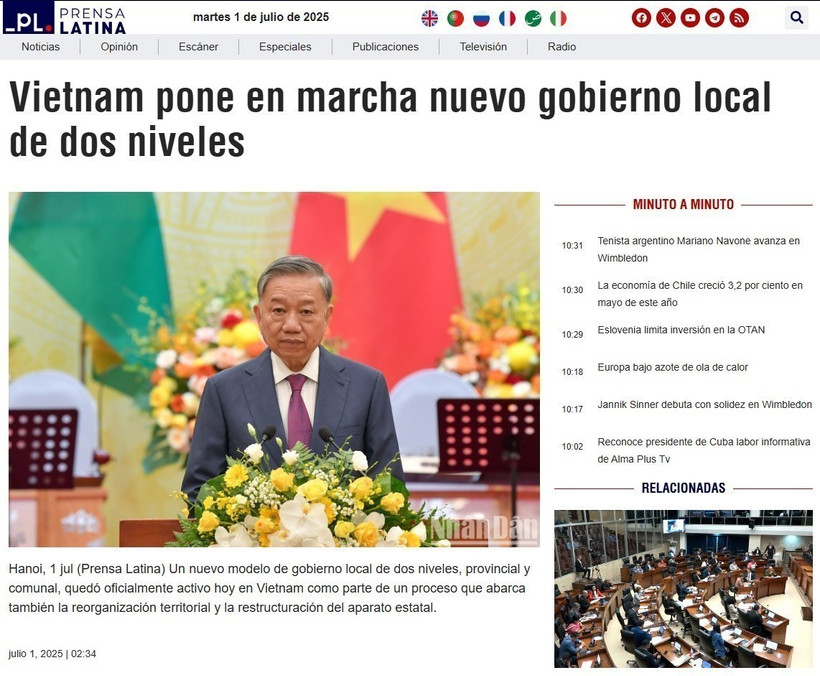
See more

Singapore considers building 6th desalination plant
The total water demand in Singapore is projected to rise with industrial growth. In 2065, non-domestic demand is expected to account for more than 60% of water demand, up from the current 55%.

Thailand warns of four scam trends to watch in 2026
The four scam methods most frequently found are fake SMS/LINE messages with links demanding payment; AI-powered deepfake calls and fake videos; bogus crypto or “digital stock” investment schemes; and fake profiles on social apps: romance scams, fake shops and fake hotels.

Philippines poised to shape future of regional tourism
Tourism Secretary Christina Frasco said looking ahead, the Philippines prepares to host the United Nations Tourism Global Forum on Gastronomy and the ASEAN Tourism Forum (ATF) 2026 in Cebu, affirming the country’s leadership and resilience in shaping the future of tourism in the region.

Malaysia–Thailand Caravan launched to boost Hat Yai tourism
The caravan was officially sent off in Hat Yai on December 24, with TAT Governor Thapanee Kiatphaiboon joining board members, executives, local business leaders, partner associations, and media representatives to dispatch a convoy of 30 cars and 22 big bikes from Malaysia, carrying more than 100 participants, from the Buri Sriphu Hotel in Songkhla province.

Major trends shaping Southeast Asia next year and opportunities for Vietnam
Maybank noted that FDI metrics continued to improve in Malaysia, Vietnam and Thailand in 2025, but slowed in Indonesia and the Philippines.
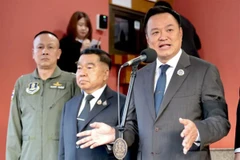
Thailand, Cambodia agree on terms of initial ceasefire
The Thai Minister of Defence will attend a Thailand – Cambodia GBC meeting with the Cambodian counterpart on December 27 in Chanthaburi, with the aim of finalising a joint statement under the Kuala Lumpur Agreement.

Bus accident kills 4, injures 23 in Philippines
The bus, which was carrying 27 people, including the driver and the alternate driver, was traveling southbound from Metro Manila, and the accident occurred in the municipality of Del Gallego.

Myanmar finalises schedule for general election ballots
The first round of ballots is scheduled for December 28, 2025, with a second round due on January 11. However, the timeline for vote counting and the announcement of election results has not yet been released.
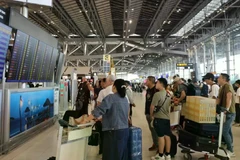
Thailand: Air travel surges ahead of New Year as seats added, fares cut
To accommodate the surge, CAAT arranged 66 special flights, adding 11,312 seats on routes connecting Bangkok with Krabi, Chiang Mai, Chiang Rai, Khon Kaen, Trang, and Samui. Airlines have also reduced fares by 30% from the maximum ceiling, offering 36,620 discounted seats across 202 flights on 11 routes, including services from Bangkok to Hat Yai, Nakhon Si Thammarat, Surat Thani, Phuket, Chumphon, and other major destinations.
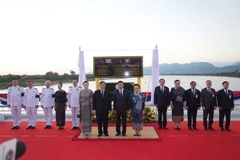
New bridge inaugurated to boost Laos–Thailand–Vietnam trade connectivity
The 1,350m bridge significantly shortens the distance from Buengkan in northeastern Thailand, through Bolikhamxay in central Laos, to the Cau Treo border gate in Vietnam’s central Ha Tinh province to just over 200 km, compared to more than 350 km previously, creating the shortest and most convenient route for transporting goods from Thailand to Vietnam.

Thailand’s November exports rise 7.1%
Thailand's exports continued to be driven mainly by electronics shipments, in line with the upswing in the computer cycle and the expansion of modern technologies, including AI, which has boosted demand for manufactured goods.

Indonesia extends tax incentives through 2026 to attract investment
The new regulation will also be aligned with the global minimum tax regime agreed under the Organisation for Economic Co-operation and Development (OECD), which requires multinational companies to pay a minimum effective corporate tax rate of 15%.

Indonesia probes corporate responsibility for floods, landslides
The Indonesian government through the Forest and Mining Area Control Task Force (Satgas PKH) has found indications of a number of corporate and individual entities that contribute to the occurrence of floods and landslides in Aceh, North Sumatra, and West Sumatra.

Indonesia tops world in methanol poisoning cases
Indonesia tops the list with more than 300 methanol poisoning incidents, affecting 2,185 people and recording a mortality rate of up to 50.4%, a level described by experts as exceptionally high. Cambodia ranks second, with over 1,300 people affected, though its fatality rate is significantly lower at around 14.2%.

Indonesia steps up security for Christmas, New Year holidays
With the 2025 year-end holiday fast approaching, Indonesia’s National Police have stepped up security measures nationwide, deploying hundreds of thousands of personnel to ensure the public can celebrate Christmas and New Year safely.

Thai PM contenders begin to take shape ahead of February election
Thailand’s caretaker leader Anutin Charnvirakul has been selected by the Bhumjaithai Party as its candidate for prime minister in the general election scheduled for early February 2026.

Thailand, Cambodia reach preliminary agreements
The initial talks focused on setting the agenda for a full-delegation meeting scheduled for 9:00 am on December 25.

Cambodia, Thailand start General Border Committee Secretariat Meeting
In this meeting, both parties will discuss and exchange documents to prepare for the upcoming 3rd Special GBC Meeting, scheduled to be held on December 27, to ensure the cessation of hostilities and find solutions to restore stability between the two countries, as well as to facilitate a swift return to normalcy.
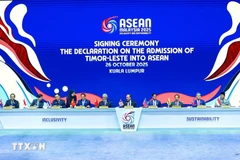
Top 10 standout international events in 2025
The US's imposition of reciprocal tariffs, the Thailand – Cambodia border conflict, and the AI race are among the 10 prominent international events in 2025 as selected by the Vietnam News Agency.

Indonesia increases synergy to ensure smooth year-end public mobility
To ensure policies, operational measures, and on-the-ground responses are well coordinated, cross-sector collaboration is being managed through the Indonesian Transportation Ministry’s command post.
